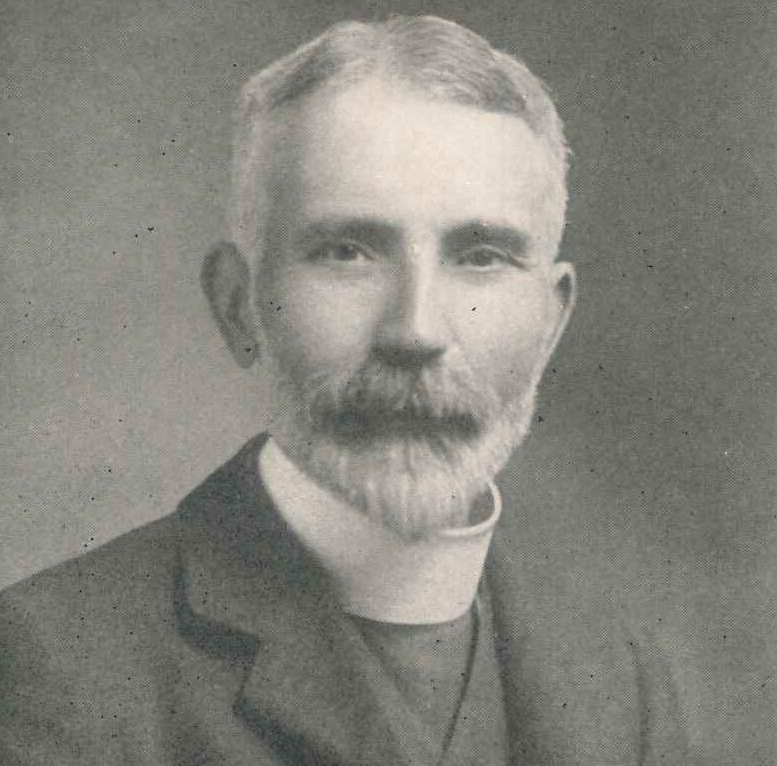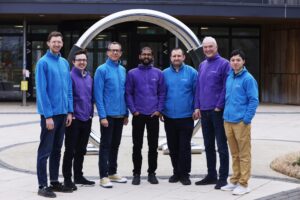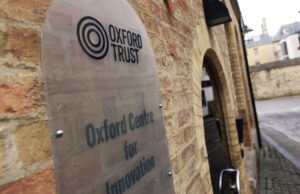The story of John Stansfeld, the man behind Stansfeld Park
November 3, 2017

Nearly one hundred years ago, a rector called John Stansfeld bought some land in Headington to create a rural refuge for the urban poor of his Oxford parish. He believed that access to the countryside was essential to the health, welfare and education of young people. Fast forward to 2017 and The Oxford Trust now owns the site and named it Stansfeld Park in John’s honour. We are now developing an exciting new science education centre and innovation centre here to inspire a whole new generation about the wonders of the world around them.
John Stansfeld was a man both rooted in his time and also ahead of his time. This is his story…
The Early Years
John Stedwell Stansfeld was born in Lincolnshire in 1855, the son of Alfred Stansfeld and Eliza Stedwell . After leaving school at 15, he passed his civil service exams and worked for Customs & Excise in London. He was then transferred to Oxford where he took the opportunity, while still working, to enrol as an undergraduate at Exeter College at the University of Oxford to study theology. He completed a BA in theology in 1889 and an MA in 1892. John’s mind was set on taking orders so he continued his studies part-time at Wycliffe Hall but his poor salary pushed him to change and read medicine to support his family. He couldn’t afford to give up his civil service position but was subsequently appointed to a job in London that was less demanding. His energy went into studying medicine at Charing Cross Hospital and he qualified as a doctor in 1897. From then on, he was nicknamed ’the doctor’ which is why the biography of Stansfeld by Barclay Baron has this title.
The Mission in Bermondsey
After a meeting of two old friends – Henry Gibbon and Edwyn Barclay – from Wycliffe Hall in 1897, John received an invitation to found a small medical mission in Bermondsey, then one of the poorest boroughs of London. The so-called Oxford Medical Mission was started in a small house on Abbey Road with the purpose to ’primarily spread Christ’s Kingdom.’
John’s days were packed with activity – he worked for Customs & Excise during the day and ran a medical surgery and boys club in Bermondsey in the evenings. Those who knew him said that they never saw him sleep! However, he managed to find time to marry Janet Marples, a social worker in Bermondsey, in 1902, and in 1903 their first son, John Gordon Stansfeld, was born followed three years later by a daughter, called Phyllis Janet Stansfeld. For the next sixteen years, John and Janet worked side by side rearing their family and trying to help improve the lives of the residents of Bermondsey.
At the turn of the century, John surprised his colleagues at the mission by buying a piece of land in Horndon-on-the-Hill in Essex in order to create a boys summer camp. He wanted to give the deprived children of the parish a haven away from the city – a place to escape, explore and enjoy. On the site, he built a ’castle’ from the wreckage of an old Bermondsey church. He also built Wycliffe House – a long, low hut suitable for meals and gatherings. John obviously had great foresight as this was a few years before Baden Powell formed the Scouts, a movement that made camping and outdoor exploration for young boys popular all around the UK. In 1903 he extended the original Bermondsey mission to another site at Dockhead, just east of Tower Bridge, and other outposts followed.
Vicar of St Ebbes, Oxford
In 1909 John took voluntary redundancy from Customs & Excise and was ordained the following year at Southwark Cathedral. His daughter’s poor health prompted a move and ’the doctor’ was offered the job as rector of the Parish of St Ebbes, Oxford, where he was to serve for the next 14 years. At that time, St Ebbes was a desperately poor and overcrowded part of Oxford. One of the first things John did was to set up a medical dispensary in the vicarage, open the gardens for local children to play in and, with the help of his old college, started the Exeter College Boy’s Club. He worked tirelessly to improve the living conditions of his parishioners but never was his daily round harder than in the winter of 1918/19 when St Ebbes was stricken – like many other parishes, villages, towns and cities across Europe – with the influenza epidemic. One of the victims of this brutal flu epidemics was Janet Stansfeld, who sadly died. In grief, John commissioned a memorial to Janet on the south side of the church, along with commemorative stained-glass window, which can still be seen today.
A Woodland Venture
His Bermondsey experience made John a firm believer in experiencing the great outdoors as both a prime means of health and as a spiritual opportunity. With the money that he’d put aside to visit the Holy Land with Janet (a dream of hers), he bought some 20 acres of land on the hill at Shotover, near the eastern boundary of Oxford, with a vision for creating a new outdoor retreat. It would serve as a space where boys could come and pitch tents, explore and have adventures as well as providing respite for all the children of St Ebbes. John Stansfeld designed and constructed two tiny houses – one circular and one a Swiss-style chalet – where poor families from St Ebbes could go for a week’s holiday. The advantage of the site was that the breadwinner could still walk down the hill to work in Oxford every morning so there was no loss of pay.
The site had once been a quarry, providing building stone for the Oxford colleges, but was now a wasteland, making it perfect for development. With help from some undergraduate labour (including Douglas Downes), and the boys staying at the camp, John’s first task was to dig a swimming bath and build a tree house he called the ‘bird’s nest’ in the tree tops.
In one corner of the site he built his most ambitious building – St Ebba’s Priory, a little church of stone with a thatched roof, and a small bungalow for his own use and the entertainment of friends.
During his time at St Ebbes, John was well-remembered for these big gestures but smaller ones too. One story goes that he was in the rectory drawing-room in St Ebbes one day when a man came in awkwardly, explaining that he could not take the job offered to him because he had no decent boots, and how ’the Doctor’ immediately sat down , took off his own boots and said “Try those”. He gave up his own footwear to help another who needed them more.
An African Odyssey
In 1925, at the age of 70, John left St Ebbes and set off for Kenya, to take up a post as a missionary in Masano, close to Lake Victoria. Soon after his arrival, the Bishop of Mombasa appointed him principal of the local school, which he ran for two years. With the help of his sister, Jessie, he worked tirelessly for the betterment of the school and area. One of the main things he was remembered for was building a local swimming bath – apparently one of the finest in Africa!
Back to Oxford
On his return in 1929, John was appointed to a country parish – in Spelsbury, close to Charlbury. He was quick to start a men’s club in the vicarage and a boy’s club in the barn. He also continued running boy’s camps at Shotover and by this time had made contact with a slum parish in Birmingham and began to bring parties from there too.
The links with Birmingham extended to his Cotswold parish and he started exchange progammes between the rural idyll of Spelsbury and the city parish of St Saviour’s in Birmingham. This town and country partnership lasted for years. Under John’s tenure, Spelsbury also hosted visits from Bermondsey and St Ebbes.
He died as he lived
He died as he lived – attending others. A much-loved friend was desperately ill so he set out in the cold rain to walk the two miles to her house. In the early hours, he returned home wet, exhausted and plainly ill. Five days later, John passed away, aged 85, on Sunday 17th December, 1939.
A legacy
Bermondsey, an Oxford parish, an African school and a Cotswold village owe a lot to John Stansfeld. A blue plaque was unveiled in 2009 at the former St Ebbes Rectory (now part of Cherwell Tutorial College) on Paradise Square to recognise his work.
Before his death John sold the Shotover site, with the exception of one corner, to the Birmingham Education Authority (BEA). The BEA created the Stansfeld Outdoor Study Centre which provided an outdoor activity and residential centre for Birmingham’s school children. Eventually the site became the Stansfeld Outdoor Education Centre and was owned by Birmingham City Council until 2016, when it was bought by The Oxford Trust.
That one tiny corner of land that John kept was given to his sister after his death – once he was gone it paid her a small annual sum for life from the rental income of four small properties.
John’s children also inherited his tireless energy, Phyllis – later called Janet – taught in an English mission school in Cairo and Gordon continued his father’s work in Bermondsey before being appointed to a school in Burma. Sadly, he had only been there nine months when he accidentally drowned in the Irrawaddy while chasing a runaway.
Nearly one hundred years on, The Oxford Trust is rejuvenating the Stansfeld site and fulfilling some of the original aims of John Stansfeld by building the UK’s first indoor-outdoor science education centre for primary-aged children. The woodland will give children the opportunity to experience the natural world, to learn what biodiversity is all about and to develop a lasting enthusiasm for science.
We are now pleased to have made links with John Stansfeld’s great great nephews, Wyon and Philip, and hope they will be part of the centenary celebrations when our new centre opens at Stansfeld Park in Spring 2019.



